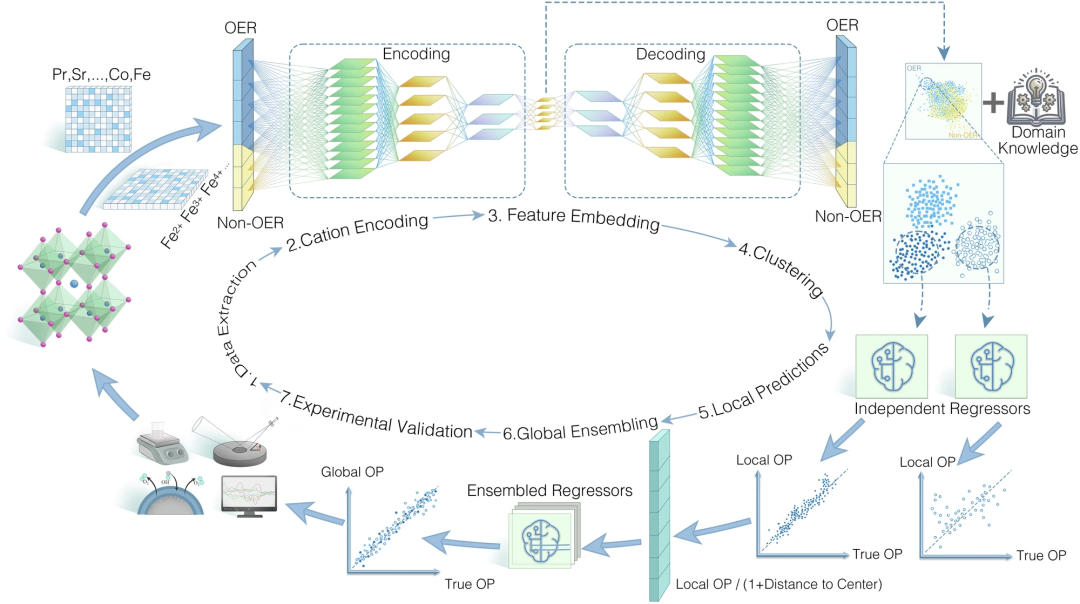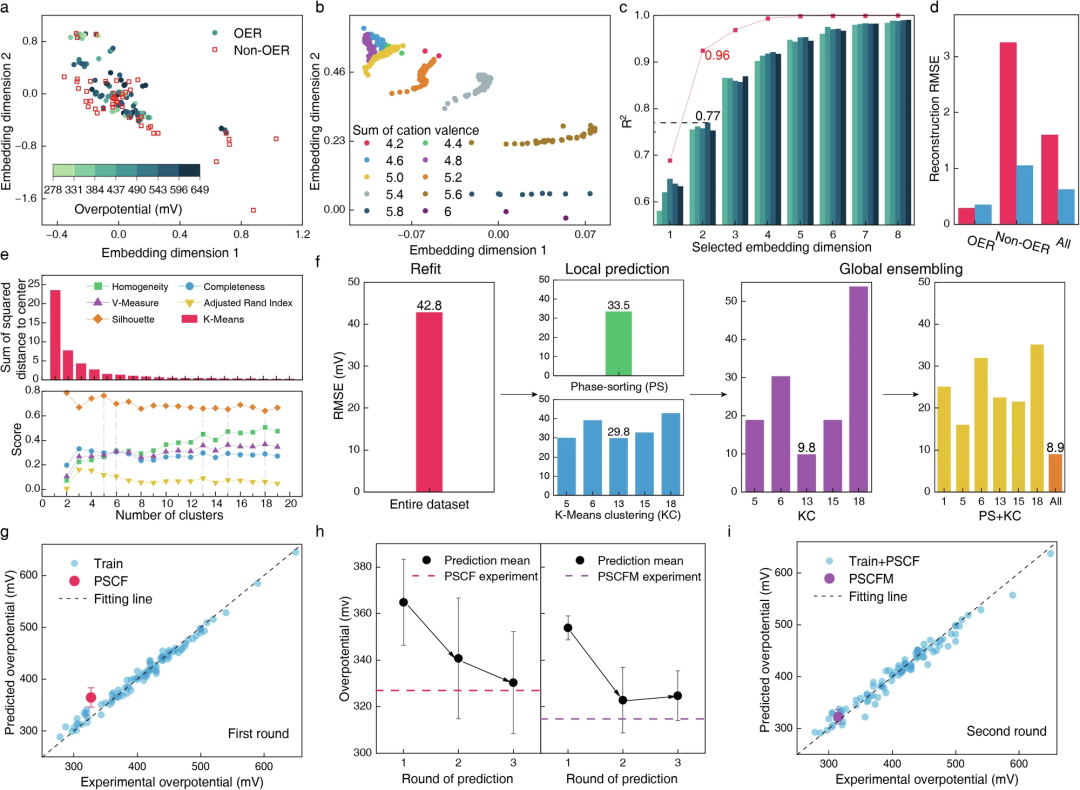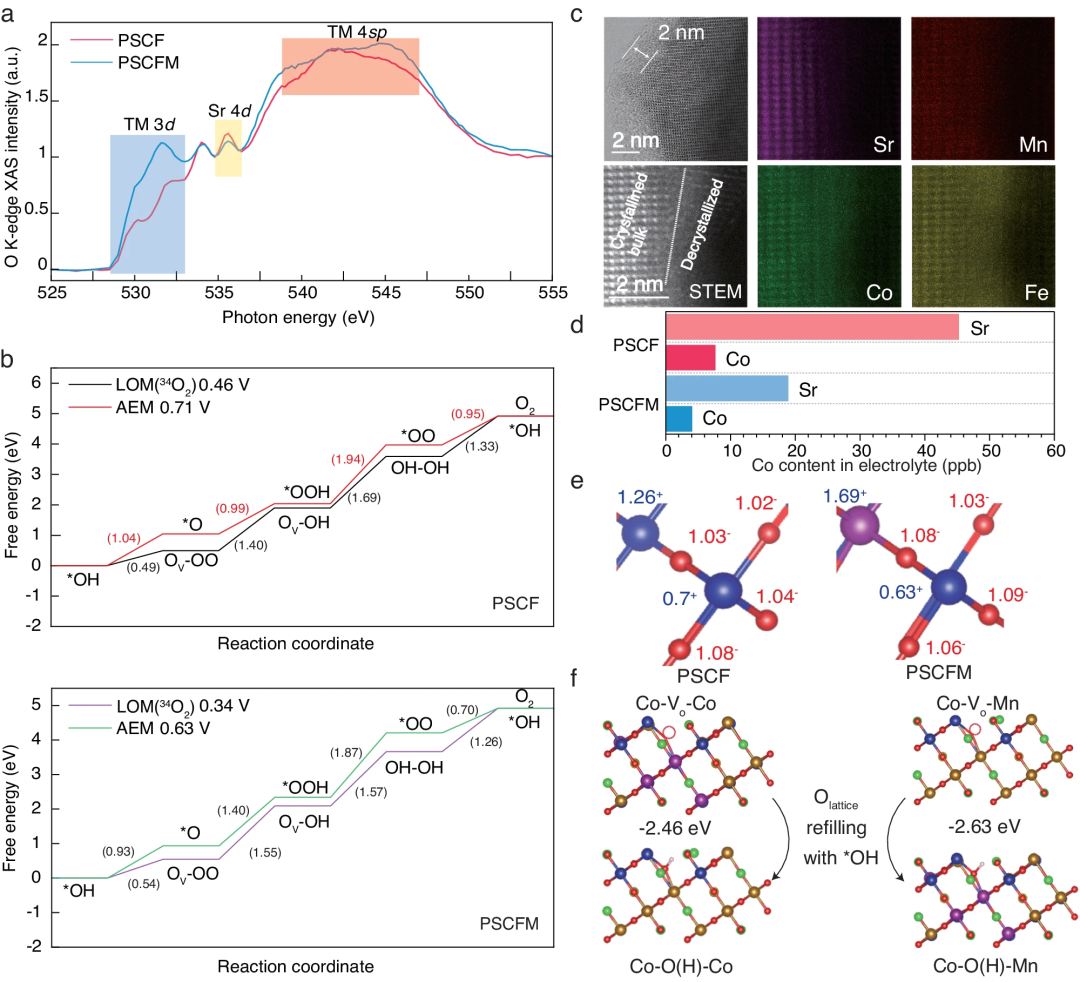


Perovskite oxide materials play a key role in green electrosynthesis of value-added chemicals, a key step towards achieving carbon neutrality.
A noteworthy application is their use in the oxygen evolution reaction (OER), which can be combined with various cathodic reactions. However, OER is still kinetically slow, involving a 4-step proton-electron coupled transfer process. Therefore, it is crucial to develop efficient and economical electrocatalysts.
Previous studies have shown that incorporating various cations (Ce, Pr, Cr, Sr, V, W, Co, Fe, Mn, Nb, Mg, etc.) into the A site or B site of perovskite oxide can Effectively adjust the local coordination environment and electronic structure, thereby improving electrocatalytic performance. However, its specific chemical composition remains unexplored due to the inefficiency of the trial-and-error approach to material discovery.
High-throughput density functional theory (DFT) calculations often require prior knowledge of specific algorithms or methods, hindering data unification between different systems and limiting their generalizability.
AI has huge potential in discovering new electrocatalysts. However, ML algorithms based on feature selection and simplification often eliminate less important descriptors, inevitably leading to information loss and reduced prediction accuracy. Furthermore, different algorithms often produce inconsistent results when analyzing the relative importance of the same data set.
Apart from the choice of algorithm, the quality and quantity of data also play a crucial role in determining the accuracy of ML-based predictions. Traditional simulation databases derived from DFT are often limited to a single or a few similar systems, thus limiting the applicability and generalizability of the extracted knowledge. Furthermore, experimental data are relatively scarce and difficult to integrate due to the lack of universally accepted standards for reporting experimental methods.
Transfer Learning Paradigm
To address this challenge, the Xiamen University team proposed a powerful transfer learning paradigm centered on the cation information of perovskite oxide electrocatalysts. This method utilizes pre-trained models to efficiently combine OER data with a large number of datasets from different research areas, covering a wider range of perovskite compositions.
An ensemble approach is adopted to combine models derived from different sub-clusters identified by combining domain knowledge and unsupervised learning techniques. This strategy facilitates knowledge transfer between different material systems, significantly improving prediction accuracy.
The proposed transfer learning paradigm consists of seven steps:
Due to limited data on OER perovskite oxides, the researchers also collected data on non-OER perovskite oxides. This approach expanded the dataset from 94 to 140 entries, an increase of 48.9%. The rich data set covers a variety of features, including material composition, oxygen vacancy concentration, and chemical valence state distribution.

The researchers conducted experimental verification of the candidate materials. Because predicting the properties of perovskite oxide materials with higher structural entropy is inherently complex, initial predictions were limited to quaternary and quinary compositions.
30 formula kimia telah dipilih daripada lebih 5 juta mata ramalan untuk pengesahan percubaan. Yang penting, bahan yang terdiri daripada PSCF diramalkan sebagai bahan berprestasi tinggi dengan lebihan potensi minimum 340.81 mV (364.80 ± 18.55 mV). Penilaian voltammetri imbasan linear awal (LSV) mengesahkan potensi berlebihan PSCF menjadi 327 mV.

1 Dari pusingan kedua ramalan:
Gabungan kaedah pembelajaran aktif memanjangkan keupayaan ramalan kepada sistem bahan enam elemen yang lebih kompleks di mana Mn menggantikan sebahagian Fe dalam PSCF mencapai 302.92 mV Potensi lebihan minimum yang diramalkan ialah (322.75 mV ± 14.09 mV).
2 Selepas itu, semua bahan terpilih ini telah direka, XRD disaring dan dinilai oleh ukuran LSV:
Selaras dengan ramalan, PSCFM menunjukkan pengurangan potensi berlebihan sebanyak 315 mV pada 10 mA cm^−2, Kebolehpercayaan model adalah. disahkan.
3 Pengesahan lanjut strategi pembelajaran aktif:
melibatkan memasukkan pengedaran valens PSCFM yang dikodkan dengan tepat ke dalam set latihan untuk kitaran ramalan ketiga.
4 Penyelidikan menunjukkan:
Walaupun sistem enam elemen itu sendiri adalah kompleks, menerapkan strategi pembelajaran aktif boleh meningkatkan ketepatan ramalan.

Pencirian yang komprehensif menunjukkan bahawa oksigen kekisi memainkan peranan penting dalam mempromosikan gandingan O-O semasa OER. Pengiraan DFT menjelaskan lagi asas mekanistik untuk aktiviti OER yang dipertingkatkan ini. Penggabungan Mn ke dalam PSCF meningkatkan kestabilan tapak tindak balas Co sambil merendahkan halangan tindak balas pada motif Mn-O-Co melalui laluan mekanisme oksigen kekisi (LOM).
Pendekatan ini menunjukkan keberkesanan pembelajaran pemindahan dan pembelajaran aktif dalam mengatasi had data dan meramalkan pemangkin OER dengan tepat. Penyelidikan ini mewujudkan paradigma ML yang berkuasa yang membuka jalan untuk mempercepatkan pembangunan pemangkin OER berprestasi tinggi.
Nota: Muka depan datang dari Internet
The above is the detailed content of Xiamen University team's material prediction transfer learning paradigm was published in Nature sub-journal and discovered high-performance catalysts. For more information, please follow other related articles on the PHP Chinese website!
 How to use the print function in python
How to use the print function in python
 How to compress html files into zip
How to compress html files into zip
 Can the appdata folder be deleted?
Can the appdata folder be deleted?
 What are the commonly used libraries in golang?
What are the commonly used libraries in golang?
 What to do if the blue screen code 0x0000007e occurs
What to do if the blue screen code 0x0000007e occurs
 asp what file
asp what file
 notepad++ official website
notepad++ official website
 Introduction to the meaning of invalid password
Introduction to the meaning of invalid password
 minidump.dmp
minidump.dmp




